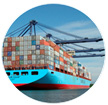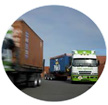ANNEX VI MARPOL: PREVENTION AGAINST AIR POLLUTION & MARPOL V GARBAGE MANAGEMENT PLAN (GMP) ON A SHIP
ANNEX VI MARPOL: Prevention against air pollution & marpol v garbage management plan (gmp) on…

The electronic seal is a protection and security device that accompanies the goods throughout the entire process.
The electronic seal is applied by the authorized Customs officer at the time of consolidation and closure of the container. The electronic seal accompanies the cargo to its final destination, providing pre-established information and allowing automatic control along the entire transport and logistics chain


The electronic seal is applied by the authorized Customs officer in the Customs of Entry and is validated and removed when the goods leave the country.


The electronic seal is applied by the authorized Customs officer in the Customs primary sector for those containers that go to the fiscal deposit, remaining until their final release once the cargo has been nationalized and delivered to the end customer.



1. The customs officer authorized to operate on the system applies the e-seal assigned to the cargo and checks the adequacy of the cargo data associated with it, as per the documentation of each individual case.
Each e-seal contains a unique serial code, readable with an appropriate reader (mobile or fixed), as well as a code (alphanumeric or barcode) printed on the visible faces of the e-seal, thus also allowing visual inspection and traceability of the e-seal itself from production to final destruction.

2. Using the appropriate RFID reader, in accordance with the requirements established by the relevant authorization levels, the following operations are performed:

3. With the information described, a single archive can be produced, indexable according to the criteria deemed appropriate.
Using the reader, it is possible to have real-time communication via GSM / GPRS or WiFi with a central server for information collection and processing.
DURING THE TRIP
IN DEPOSIT
Throughout the journey, the Customs officer and / or the Security Authorities, by using portable or fixed readers installed at the control points (gates, etc.,) can independently verify:
E-SEAL APPLICATION
When the e-seal is applied, the following information can be electronically transferred to it:
TRANSPORT
At each stage and during transit it is possible to electronically check the status of the e-seal and the integrity of the information.
E-SEAL REMOVAL
At destination, after verifying the integrity of the information in electronic format, the e-seal is removed and destroyed.
The described system substantially contributes to the improvement of the prevention of contamination / tampering of the goods in international freight, as it is possible to check the cargo data for the entire journey of the goods, without opening the container.
© 2021 LeghornGroup IT Team 7401-A496